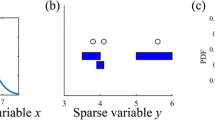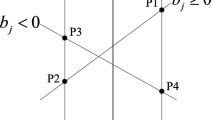Abstract
This paper proposes a new methodology to model uncertainties associated with functional random variables. This methodology allows to deal simultaneously with several dependent functional variables and to address the specific case where these variables are linked to a vectorial variable, called covariate. In this case, the proposed uncertainty modelling methodology has two objectives: to retain both the most important features of the functional variables and their features which are the most correlated to the covariate. This methodology is composed of two steps. First, the functional variables are decomposed on a functional basis. To deal simultaneously with several dependent functional variables, a Simultaneous Partial Least Squares algorithm is proposed to estimate this basis. Second, the joint probability density function of the coefficients selected in the decomposition is modelled by a Gaussian mixture model. A new sparse method based on a Lasso penalization algorithm is proposed to estimate the Gaussian mixture model parameters and reduce their number. Several criteria are introduced to assess the methodology performance: its ability to approximate the functional variables probability distribution, their dependence structure and their features which explain the covariate. Finally, the whole methodology is applied on a simulated example and on a nuclear reliability test case.















Similar content being viewed by others
References
Anstett-Collin F, Goffart J, Mara T, Denis-Vidal L (2015) Sensitivity analysis of complex models: coping with dynamic and static inputs. Reliab Eng Syst Saf 134:268–275
Bien J, Tibshirani RJ (2011) Sparse estimation of a covariance matrix. Biometrika 98:807–820
Bongiorno E, Goia A (2015) Some insights about the small ball probability factorization for hilbert random elements. http://arxiv.org/abs/1501.04308
Bongiorno E, Goia A (2016) Classification methods for hilbert data based on surrogate density. Comput Stat Data Anal, 99, 204–222. http://arxiv.org/abs/1506.03571
Bongiorno EG, Salinelli E, Goia A, Vieu P (2014) Contributions in infinite-dimensional statistics and related topics. Societa Editrice Esculapio. doi:10.15651/978-88-748-8763-7
Conover WJ (1971) Practical Nonparametric Statistics. Wiley, New York
De Rocquigny E, Devictor N, Tarantola S (2008) Uncertainty in industrial practice. Wiley, New York
Delaigle A, Hall P (2010) Defining probability density for a distribution of random functions. Ann Stat 38(2):1171–1193
Dempster AP, Laird NM, Rubin DB (1977) Maximum likelihood from incomplete data via the EM algorithm. J R Stat Soc Series B (Methodological) 39:1–38
Ferraty F, Vieu P (2006) Nonparametric functional data analysis: theory and practice. Springer Science & Business Media, Berlin
Friedman J, Hastie T, Tibshirani R (2008) Sparse inverse covariance estimation with the graphical Lasso. Biostatistics 9:432–441
Fromont M, Laurent B, Lerasle M, Reynaud-Bouret P (2012) Kernels based tests with non-asymptotic bootstrap approaches for two-sample problem. In: 25th annual conference on learning theory 23:1–22
Ghanem RG, Spanos PD (1991) Stochastic finite elements: a spectral approach. Springer, Berlin
Goia A, Vieu P (2016) An introduction to recent advances in high/infinite dimensional statistics. J Multivar Anal, 146, 1–6. Special issue on statistical models and methods for high or infinite dimensional spaces
Hastie T, Tibshirani R (1990) Generalized additive models. Chapman and Hall/CRC, Boca Raton
Helton J, Johnson J, Sallaberry C, Storlie C (2006) Survey of sampling-based methods for uncertainty and sensitivity analysis. Reliab Eng Syst Saf 91(10–11):1175–1209
Horváth L, Kokoszka P (2012) Inference for functional data with applications. Springer, Berlin
Höskuldsson A (1988) PLS regression methods. J Chemom 2:211–228
Hyndman RJ, Shang HL (2010) Rainbow plots, bagplots, and boxplots for functional data. J Computat Graph Stat 19:29–45
Jacques J, Preda C (2014a) Functional data clustering: a survey. Adv Data Anal Classif 8(3):231–255
Jacques J, Preda C (2014b) Model-based clustering for multivariate functional data. Computat Stat Data Anal 71:92–106
Loève M (1955) Probability theory. Springer, Berlin
Ma X, Zabaras N (2011) Kernel principal component analysis for stochastic input model generation. J Comput Phys 230(19):7311–7331
Marrel A, Iooss B, Van Dorpe F, Volkova E (2008) An efficient methodology for modeling complex computer codes with gaussian processes. Comput Stat Data Anal 52(10):4731–4744
Mclachlan J, Krishnan T (1997) The EM algorithm and extension. Wiley inter-science, New York
Oakley J, O’Hagan A (2002) Bayesian inference for the uncertainty distribution of computer model outputs. Biometrika 89(4):769–784
Pearson K (1901) On lines and planes of closest fit to systems of points in space. London Edinburgh Dublin Philos Mag J Sci 2:559–572
Popelin AL, Iooss B (2013) Visualization tools for uncertainty and sensitivity analyses on thermal-hydraulic transients. In: SNA+ MC 2013—Joint international conference on supercomputing in nuclear applications and Monte Carlo
Ramsay JO, Silverman BW (2005) Functional data analysis. Springer, Springer Series in Statistics, Berlin
Rasmussen CE, Williams CKI (2006) Gaussian processes for machine learning. MIT Press, Cambridge
Rosenblatt M (1956) Remarks on some nonparametric estimates of a density function. Ann Math Stat 27(3):832–837
Sacks J, Welch WJ, Mitchell TJ, Wynn HP (1989) Design and analysis of computer experiments. Stat Sci 4(4):409–423. doi:10.2307/2245858
Schwarz G (1978) Estimating the dimension of a model. Ann Stat 6:461–464
Scott DW (2009) Multivariate density estimation: theory, practice, and visualization. John Wiley & Sons, Hoboken
Van Deun K, Smilde A, van der Werf M, Kiers H, Van Mechelen I (2009) A structured overview of simultaneous component based data integration. BMC Bioinform 10:246–261
Wan J, Zabaras N (2014) A probabilistic graphical model based stochastic input model construction. J Comput Phys 272:664–685
Wang H (2013) Coordinate descent algorithm for covariance graphical Lasso. Stat Comput 6:1–9
Welch WJ, Buck RJ, Sacks J, Wynn HP, Mitchell TJ, Morris MD (1992) Screening, predicting, and computer experiments. Technometrics 34(1):15–25
Wold H (1966) Estimation of principal components and related models by iterative least squares. Academic Press, Cambridge
Wu CFJ (1983) On the convergence properties of the EM algorithm. Ann Stat 11:95–103
Author information
Authors and Affiliations
Corresponding author
Rights and permissions
About this article
Cite this article
Nanty, S., Helbert, C., Marrel, A. et al. Uncertainty quantification for functional dependent random variables. Comput Stat 32, 559–583 (2017). https://doi.org/10.1007/s00180-016-0676-0
Received:
Accepted:
Published:
Issue Date:
DOI: https://doi.org/10.1007/s00180-016-0676-0




